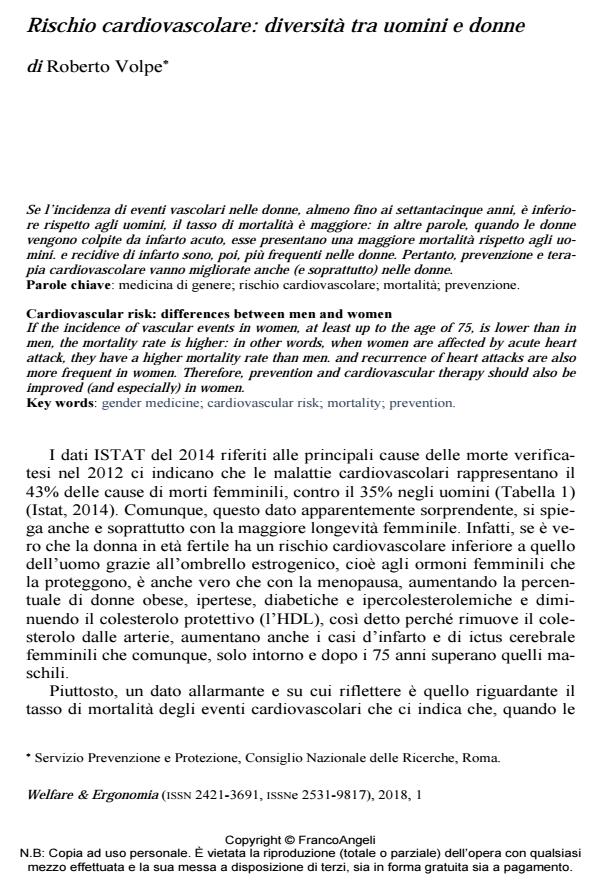Cardiovascular risk: differences between men and women
Journal title WELFARE E ERGONOMIA
Author/s Roberto Volpe
Publishing Year 2019 Issue 2018/1 Language Italian
Pages 8 P. 135-142 File size 243 KB
DOI 10.3280/WE2018-001009
DOI is like a bar code for intellectual property: to have more infomation
click here
Below, you can see the article first page
If you want to buy this article in PDF format, you can do it, following the instructions to buy download credits

FrancoAngeli is member of Publishers International Linking Association, Inc (PILA), a not-for-profit association which run the CrossRef service enabling links to and from online scholarly content.
If the incidence of vascular events in women, at least up to the age of 75, is lower than in men, the mortality rate is higher: in other words, when women are affected by acute heart attack, they have a higher mortality rate than men. and recurrence of heart attacks are also more frequent in women. Therefore, prevention and cardiovascular therapy should also be im-proved (and especially) in women.
Keywords: Gender medicine; cardiovascular risk; mortality; prevention.
- Crilly M.A., Bundred P.E., Leckey L.C. and Johnstone F.C. (2008). Gender bias in the clinical management of women with angina: another look at the Yentl syndrome. Journal of Womens’ Health, 17: 331-342.
- Enriquez J.R., Pratap P., Zbilut J.P, Calvin J.E. and Volgman A.S. (2008). Women tolerate drug therapy for coronary artery disease as well as men do, but are treated less frequently with aspirin, beta-blockers, or statins. Gender Medicine, 5: 53-61.
- European Guidelines on Cardiovascular Disease Prevention in Clinical Practice. The Fifth Joint Task Force of the European Society of Cardiology and Other Societies on Cardiovascular Disease Prevention in Clinical Practice (2012). European Journal of Preventive Cardiology, 19: 585-667. DOI: 10.1177/2047487312450228
- Giampaoli S., Vannuzzo D. e Gruppo di Ricerca del Progetto osservatorio Epidemiologico/Health Examination Survey (2014). La salute cardiovascolare degli italiani. Terzo Atlante italiano delle Malattie Cardiovascolari. Giornale Italiano di Cardiologia, 15(4 Suppl 1): 7S-31S.
- Healy B. (1991). The Yentl Syndrome. New England Journal of Medicine, 325: 274-276.
- ISTAT (2014). Anno 2012. Le principali cause di morte in Italia. -- Testo disponibile al sito: www.istat.it/it/files/2014/Principali_cause_morte-2012.
- Modena M.G., Volpe M. e Bellotto F. et al. (2010). Prevenzione dell’infarto del miocardio nella donna. Documento del Gruppo di Lavoro SIPREC. -- Testo disponibile al sito: https://docplayer.it/50229115-Prevenzione-dell-infarto-del-miocardio-nella-donna.html.
- Volpe R., Sotis G., Gavita R., Urbinati S., Valle S. and Modena M.G. (2012). Healthy diet to prevent cardiovascular diseases and osteoporosis. The experience of the “Pro.Sa.” project. High Blood Pressure & Cardiovascular Prevention, 19(2): 65-71.
- Wilkins E., Wilson L., Wickramasinghe K., Bhatnagar P., Leal J., Luengo-Fernandez R., Burns R., Rayner M. and Townsend N. (2017). European Cardiovascular Disease Statistics. Brussels: European Heart Network.
Roberto Volpe, Rischio cardiovascolare: diversità tra uomini e donne in "WELFARE E ERGONOMIA" 1/2018, pp 135-142, DOI: 10.3280/WE2018-001009